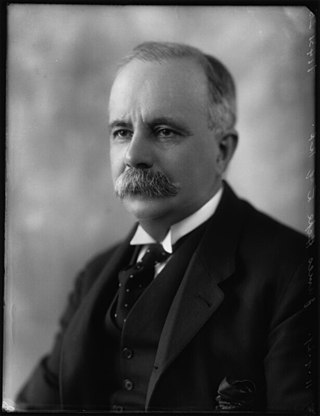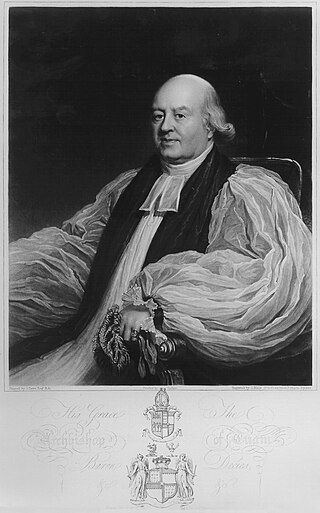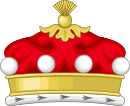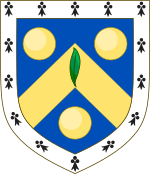
Marquess of Aberdeen and Temair, in the County of Aberdeen, in the County of Meath and in the County of Argyll, is a title in the Peerage of the United Kingdom. It was created on 4 January 1916 for John Hamilton-Gordon, 7th Earl of Aberdeen.

The title Duke of Abercorn is a title in the Peerage of Ireland. It was created in 1868 and bestowed upon James Hamilton, 2nd Marquess of Abercorn. Although the Dukedom is in the Peerage of Ireland, it refers to Abercorn, West Lothian, and the Duke also bears four titles in the Peerage of Scotland and two in the Peerage of Great Britain, and is one of only three peers who have titles in those three peerages. The Duke of Abercorn also claims the French title of Duke of Châtellerault, created in 1548.

Duke of Bedford is a title that has been created six times in the Peerage of England. The first and second creations came in 1414 and 1433 respectively, both in favour of Henry IV's third son, John, who later served as regent of France. He was made Earl of Kendal at the same time and was made Earl of Richmond later the same year. The titles became extinct on his death in 1435. The third creation came in 1470 in favour of George Neville, nephew of Warwick the Kingmaker. He was deprived of the title by Act of Parliament in 1478. The fourth creation came in 1478 in favour of George, the third son of Edward IV. He died the following year at the age of two. The fifth creation came in 1485 in favour of Jasper Tudor, half-brother of Henry VI and uncle of Henry VII. He had already been created Earl of Pembroke in 1452. However, as he was a Lancastrian, his title was forfeited between 1461 and 1485 during the predominance of the House of York. He regained the earldom in 1485 when his nephew Henry VII came to the throne and was elevated to the dukedom the same year. He had no legitimate children and the titles became extinct on his death in 1495.

Marquess of Zetland is a title in the Peerage of the United Kingdom. It was created on 22 August 1892 for the former Lord Lieutenant of Ireland, Lawrence Dundas, 3rd Earl of Zetland. Zetland is an archaic form of Shetland. The Dundas family descends from the wealthy Scottish businessman and Member of Parliament, Lawrence Dundas. In 1762 he was created a Baronet, of Kerse in the County of Linlithgow, in the Baronetage of Great Britain. The title was created with remainder, failing heirs male of his own, to his brother Thomas Dundas and the heirs male of his body. He was succeeded by his son, the second Baronet. He represented Richmond and Stirling in the House of Commons and also served as Lord Lieutenant of Orkney and Shetland. In 1794 he was created Baron Dundas, of Aske in the North Riding of the County of York, in the Peerage of Great Britain. Lord Dundas notably purchased the right to the earldom of Orkney and lordship of Zetland from James Douglas, 14th Earl of Morton.
The Peerage of the United Kingdom is one of the five Peerages in the United Kingdom. It comprises most peerages created in the United Kingdom of Great Britain and Ireland after the Acts of Union in 1801, when it replaced the Peerage of Great Britain. New peers continued to be created in the Peerage of Ireland until 1898.

Marquess of Linlithgow, in the County of Linlithgow or West Lothian, is a title in the Peerage of the United Kingdom. It was created on 23 October 1902 for John Hope, 7th Earl of Hopetoun. The current holder of the title is Adrian Hope.

Earl of Lonsdale is a title that has been created twice in British history, firstly in the Peerage of Great Britain in 1784, and then in the Peerage of the United Kingdom in 1807, both times for members of the Lowther family.

Earl of Mornington is a title in the Peerage of Ireland. It was created in 1760 for the Anglo-Irish politician and composer Garret Wellesley, 2nd Baron Mornington. On the death of the fifth earl in 1863, it passed to the Duke of Wellington; since that date, the title has generally been used by courtesy for the heir apparent to the heir apparent to the dukedom.

Earl Temple of Stowe, in the County of Buckingham, is a title in the Peerage of the United Kingdom. It was created in 1822 for Richard Temple-Nugent-Brydges-Chandos-Grenville, 2nd Marquess of Buckingham, who was created Marquess of Chandos and Duke of Buckingham and Chandos at the same time. In contrast to the Marquessate and Dukedom, which were created with remainder to the heirs male of his body only, the Earldom was created with remainder to (1) the heirs male of his body, failing which to (2) the heirs male of his deceased great-grandmother the 1st Countess Temple, failing which to (3) his granddaughter Lady Anna Grenville and the heirs male of her body, and then to possible younger daughters of Lord Temple and the heirs male of their bodies.

Baron Farnham, of Farnham in the County of Cavan, is a title in the Peerage of Ireland. It was created in 1756 for John Maxwell, who had previously represented Cavan Borough in the Irish House of Commons. John Maxwell's son, the second Baron, was created Viscount Farnham in 1760 and Earl of Farnham in 1763. Both titles were in the Peerage of Ireland but became extinct when he died childless in 1779. His brother and successor, the third Baron, was again created Viscount Farnham in 1781 and Earl of Farnham in 1785. These titles were also in the Peerage of Ireland. His son, the second Earl, sat in the House of Lords as an Irish Representative Peer from 1816 to 1823. However, he had no children and on his death in 1823 the viscountcy and earldom became extinct.

Baron St Levan, of St Michael's Mount in the County of Cornwall, is a title in the Peerage of the United Kingdom. It was created on 4 July 1887 for the former Member of Parliament Sir John St Aubyn, 2nd Baronet, becoming John St Aubyn, 1st Baron St Levan. He had previously represented Cornwall West in House of Commons as a Liberal and St Ives as a Liberal Unionist. He was succeeded by his eldest son, the second Baron, who was a Colonel and Honorary Brigadier-General in the Grenadier Guards. On his death the titles passed to his nephew, the third Baron, the son of the Hon. Sir Arthur James Dudley Stuart St Aubyn (1867–1897), second son of the first Baron. The third baron was succeeded in 1978 by his eldest son, the fourth baron, who had served with the Royal Navy at Dunkirk and in a minesweeper in Arctic Convoys during World War II and was awarded the Distinguished Service Cross (DSC). As of 2014, the titles are held by the fourth Baron's nephew, the fifth Baron, who succeeded in 2013.

Baron Savile, of Rufford in the County of Nottingham, is a title in the Peerage of the United Kingdom. It was created in 1888 for the diplomat Sir John Savile. He was the eldest of the five illegitimate children of John Lumley-Savile, 8th Earl of Scarbrough, and the grandson of John Lumley-Savile, 7th Earl of Scarbrough. The latter was the fourth of the seven sons of Richard Lumley-Saunderson, 4th Earl of Scarbrough, and his wife Barbara, sister and heiress of the politician Sir George Savile, 8th and last Baronet, of Thornhill, who bequeathed the substantial Savile estates in Yorkshire and Nottinghamshire to his nephew the Hon. Richard Lumley-Saunderson, later 6th Earl of Scarbrough. On his death the estates passed to his younger brother, the aforementioned seventh Earl, and then to his son the eighth Earl. The latter bequeathed the estates to his second natural son Captain Henry Lumley-Savile. When he died they passed to his younger brother Augustus William Lumley-Savile (1829–1887) and then to his eldest brother, the aforementioned John Savile, who was created Baron Savile the following year.
Baron Ravensdale, of Ravensdale in the County of Derby, is a title in the Peerage of the United Kingdom.
Baron Glendevon, of Midhope in the County of Linlithgow, is a title in the Peerage of the United Kingdom. It was created on 16 July 1964 for the Conservative politician Lord John Hope. He was the younger twin son of Victor Hope, 2nd Marquess of Linlithgow. As of 2017 the title is held by his younger son, the third Baron, who succeeded his elder brother in 2009.

James Fitzalan Hope, 1st Baron Rankeillour, PC, was a British Conservative politician. He served as Chairman of Ways and Means from 1921 to 1924 and again from 1924 to 1929.

William Beresford, 1st Baron Decies was an Anglo-Irish clergyman.

There have been four baronetcies created for persons with the surname Hope, three in the Baronetage of Nova Scotia and one in the Baronetage of the United Kingdom. As of 2010 one creation is extant, one dormant and two extinct.
There have been three baronetcies created for members of the Mosley family, one in the Baronetage of England and two in the Baronetage of Great Britain. Only one creation is extant. Since 1980, the title has been held jointly with Baron Ravensdale in the Peerage of the United Kingdom.
Gilbert Theophilus Clifton Clifton-Hastings-Campbell, 3rd Baron Donington was a British peer and soldier.














